Myopia: What it is, and How to Correct it
By Dr. Anthony Nappi / published June 30, 2022 / 13 min. read

Did you know that around 30% of Americans have myopia? The National Eye Institute predicts that in 2050, 50% of the population will have myopia in their lifetime. With the rise of myopia, you might wonder what you can do if affected. Perhaps you’re already looking into options. Maybe you don’t know what is myopia; that’s okay, too.
Has your phone or book been a little fuzzy? Are you squinting to see clear images? You could have Myopia. It’s possible if the symptoms are there. Did you find this article searching to out why you can’t see far away things that well? Then keep reading! This article is to help you learn about myopia. It explains everything you need to know about myopia including what it is, what it is not, types of myopia, its symptoms, its causes, and its treatments.
What is Myopia?
Myopia is the medical term for nearsightedness. This means people diagnosed with the condition can see clear images up close, but blurry images farther away. Nearsighted is the same as shortsighted.
Myopia is a refractive error, or an inability to focus light properly. Myopia occurs when the eye grows longer in the front than the back. Because of this, the retina transmits light differently than eyes of equal proportions.
Located in the back of the eye, the retina has photoreceptors wrapped around it to receive light and convert it to neurons. These neurons communicate to your brain that an image is in sight and depending on the transmission, you will see a clear or blurry image.
With standard eye size, light reflects on the retina. With myopic eyes, light reflects in front of the retina, causing a blur on items far away.
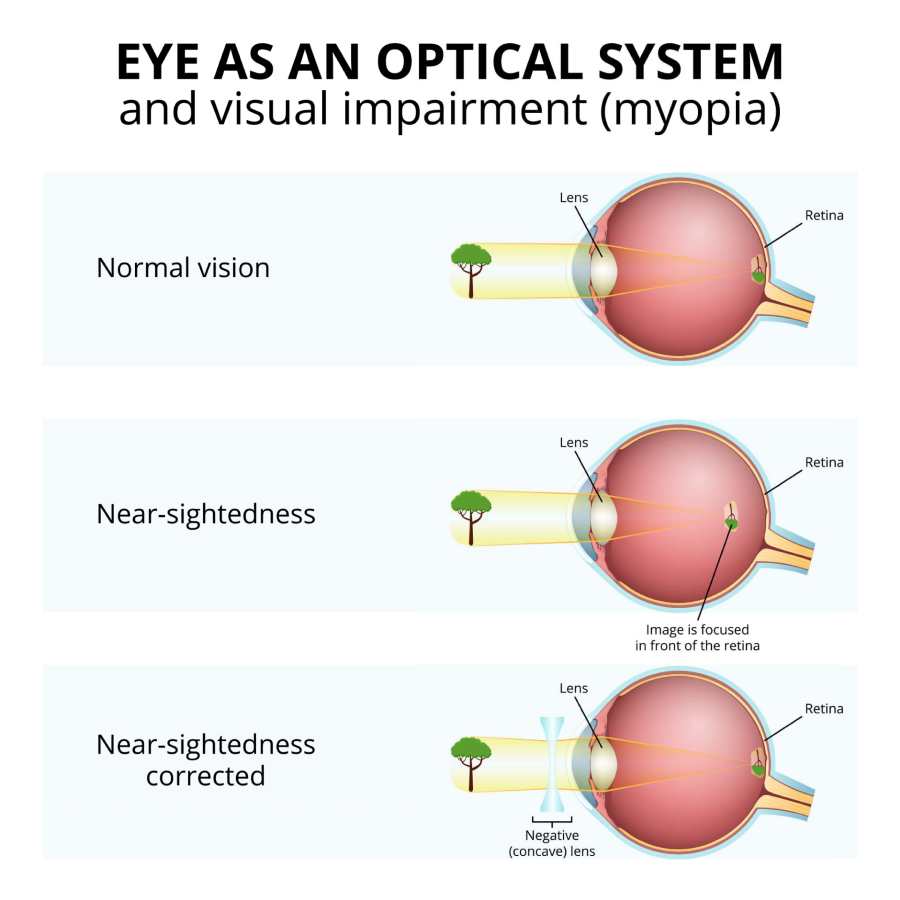
Astigmatism Vs. Myopia
Astigmatism is another refractive error where the eye does not properly translate light. Unlike myopia, with Astigmatism blurry images are both far away and near.
Astigmatism forms when your cornea or the lens of your eye does not have common shapes. Symptoms include blurry vision, cloudy vision, eye strain, headaches, and trouble seeing at night.
This condition can be genetic or developed.
Myopia vs Presbyopia
Astigmatism distorts vision at both distance and near. It is often present in combination with myopia and hyperopia. Presbyopia develops later in life, generally in one’s 40s, and causes difficulties with near vision. An eye can only be myopic or hyperopic, not both. However, presbyopia occurs with myopia, hyperopia, or astigmatism. If a person is both presbyopic and myopic, they may have difficulty with both near and far vision.
Myopia Vs. Hyperopia
Myopia means you can see up close, but not far away (near-sighted) and hyperopia (far-sighted) means you can see far away, but not up close. Hyperopia arises when the cornea is not curved enough to reflect light, or the eye is not long enough to function properly.
Since the eye is too short, or too small, light reflects behind the retina and sends information to the neurons that close-up images are blurry.
Most people are born with hyperopia but grow out of it early on. Myopia can develop throughout life.

Types of Myopia
The general scope of myopia encompasses three subgroups: simple myopia, high myopia, and pathological myopia. Keep reading for a breakdown of the different myopia types and treatments.
Simple Myopia
This condition refers to a person with healthy eyes and a slight case of myopia. It does not worsen with age. For treatment, an affected person can wear glasses or contacts.
Being on the lower side of a myopic scale, simple myopia measures between zero and six dioptres. Dioptres measure the scale of glasses or contact lenses. For example, a three dioptre prescription will have thinner lenses than a prescription with eight dioptres.
High Myopia
If your first memories are blurry recollections and you still cannot see clear images, you could have high myopia. High myopia condition occurs during childhood and the condition worsens with age.
High myopia poses more severe effects than simple myopia. You could be at risk for glaucoma, cataracts, or retinal detachment.
Pathological Myopia
Otherwise known as degenerative myopia, this condition occurs when you have other eye conditions on top of myopia symptoms. Or, when high myopia worsens and causes your eye to degenerate.
The back of the eye deteriorates with this condition and those who have pathological myopia might experience vision loss, blindness, or lattice degeneration.
Lattice degeneration thins the retinas and can cause blind spots and retinal detachments.
What Causes Myopia?
The main causes of myopia are uneven eye shapes, but other causes create myopic eyes. A big cause these days is the overuse of technology. According to Science Daily using a screen for an extended amount of time per day causes a 30% higher risk for myopia than those who limit their screen use.
Do you have to stare at screens for an endless amount of time to develop myopia? No.
Myopia can be genetic. If one, or both of your parents are myopic, there is a high chance you will be, too. Just refer back to the good old Punnett Square to test the probability.
Another huge factor causing myopia is visual stress. If you become affected by certain visual patterns or color schemes and get headaches or eye strain, you might have visual stress.
Myopia Symptoms
Of course, the most common symptom of myopia is blurry vision, but what other factors indicate you might have an issue?
- Headaches. If your head starts throbbing after looking at something far away, or you notice every time you look away from something up close you feel a twinge, you might be myopic.
- Squinting to get a clearer picture and having tired eyes after reading or seeing something in the distance can indicate myopia.
Treatments for Myopia
With the correct glasses and contact prescription, myopia symptoms can reduce. If you experience blurry vision or other any other myopic symptoms, we have good news. There are options to correct this condition permanently.
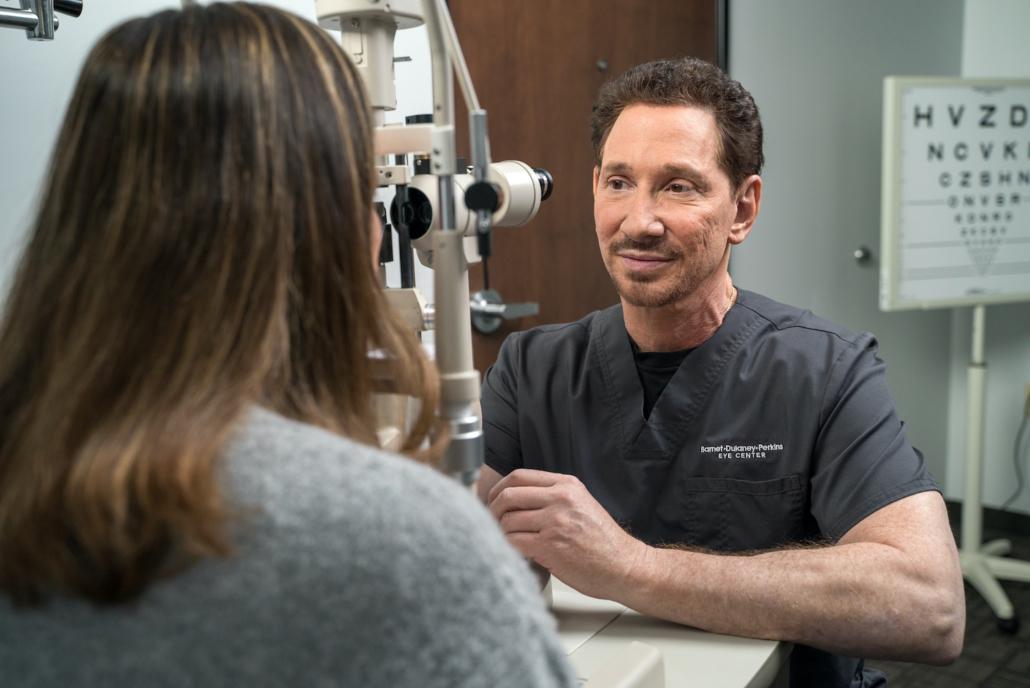
Can LASIK Fix Myopia?
The main option for patients who want a permanent solution for nearsightedness is LASIK vision correction surgery. LASIK surgery, also known as laser vision correction or refractive surgery, is one of the most common elective surgeries in North America. This procedure is designed to repair common vision problems such as nearsightedness (myopia), farsightedness (hyperopia), and chronically blurred vision (astigmatism). This safe, elective surgery uses lasers to correct issues in the eyes. It is a minimally invasive permanent way to treat this condition. You won’t have to wear your clunky glasses or worry about dry contacts ever again. LASIK remains the most common elective surgery in America.
The entire LASIK procedure lasts between ten and fifteen minutes. During that timeframe, our surgeons numb your eyes with drops and, if needed, administer medications to patients to soothe them during surgery. Then we use a lid speculum to separate the eyelid from the eye to get a clearer view of the procedure. Following the insertion of the lid speculum, our optometrists utilize lasers for LASIK.
After LASIK, you might have tired eyes, blurry vision, soreness, or fatigue. Doctors recommend sleeping or resting after the procedure. Have a driver ready to take you home after the surgery, as you will not be able to see to drive, and maybe take a few days off work. To aid the healing process, we will give you an eye shield so you don’t rub your eyes and irritate them further. We also recommend you relax for a week following the procedure. Any strenuous activity can cause delays in recovery or extra irritation to your eyes.
Can PRK Fix Myopia?
PRK is another common way to correct Myopia. PRK stands for photorefractive keratectomy. PRK surgery uses a laser to change the shape of your cornea to reduce nearsightedness, farsightedness, and astigmatism.
PRK is similar to LASIK, but the first step is different. In LASIK, a thin flap is created on the cornea and is then lifted to expose the corneal tissue and is replaced after the cornea is reshaped with a laser.
In PRK, the cornea’s thin outer layer, called the epithelium, is removed and discarded before the laser reshapes the corneal tissue. The epithelium repairs itself within a few days. Because there is no flap on the eye, PRK may be a more desirable procedure for candidates who have a high risk of eye injury.
Can LASEK Eye Surgery Fix Myopia?
LASEK eye surgery is a variation of PRK surgery that corrects myopia, hyperopia, and astigmatism. In LASEK, an excimer laser reshapes the cornea. This enables light entering the eye to properly focus on the retina for improved vision.
Similar to PRK, the epithelium is separated from the underlying corneal tissue. Unlike in PRK where the tissue is discarded, an ultra-thin flap of epithelium is pushed off to the side and remains attached instead of being discarded.
This is similar to the flap of corneal tissue that is created during LASIK surgery. In LASEK surgery, however, the hinged flap is much thinner than the corneal flap in LASIK surgery. This makes some people with naturally thin corneas a better candidate for LASEK.
LASEK may also be a better alternative for people who have professions or hobbies where they are at high risk for eye injury, which may dislodge the corneal flap LASIK surgery creates.
Other Surgical Treatment Options
Can RLE Correct Nearsightedness?
RLE stands for refractive lens exchange. In this procedure, the eye’s natural lens is replaced with an IOL. This helps patients achieve a sharper focus, which can reduce the need for bifocals or reading glasses.
RLE surgery is very similar to cataract surgery, but the difference is that in cataract surgery a cloudy lens is replaced. In RLE surgery, the lens that’s being replaced is clear.
RLE may be suitable for older patients, as well as people with extreme farsightedness and mild to moderate nearsightedness. RLE is typically recommended for people with presbyopia or extreme myopia who are not candidates for IOL, PRK, or LASIK surgeries.
EVO Visian ICL to Correct Nearsightedness
EVO Visian ICL is well-suited for a wide variety of people. Ideal candidates for EVO Visian ICL are aged 21 to 45 with nearsightedness with or without astigmatism and have maintained a stable prescription for at least one year. If you are seeking a solution to decrease or eliminate the cost and frustration of traditional contacts or glasses, EVO Visian ICL may be your answer.
If you are seeking freedom from glasses or contact lenses, the EVO Visian ICL may be right for you if you are between the ages of 21 and 45 and seeking treatment for nearsightedness with or without astigmatism.
Speak to a Doctor About Your Concerns
Are you still concerned that you might have myopia? If so, don’t stress yourself out right now. Myopia is a hassle, but it’s not a handicap.
Remember why we have optometrists and ophthalmologists. However, only your eye doctor considers things that we don’t even think about. You may have a habit that your doctor can catch and prevent surgery. If your phone or book has been a little fuzzy, relax and let me or any of our eye doctors demystify Myopia and lead you where to go, if that’s even necessary.
If you’re in the Scottsdale, Phoenix area, we’re more than happy to meet with you and give you a complimentary comprehensive eye examination and identify the issue and how to treat or prevent conditions such as Myopia. Contact us to schedule your free eye exam and consultation. We look forward to seeing you and helping you see!

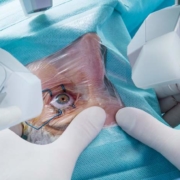 iStock
iStock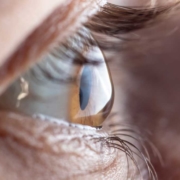
 iStock
iStock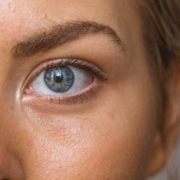
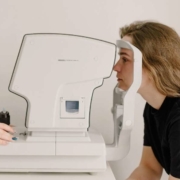
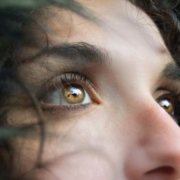 iStock Photography
iStock Photography
 iStock
iStock